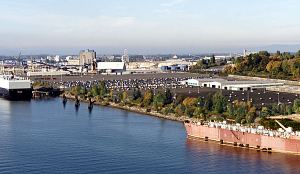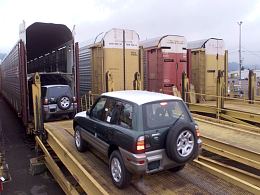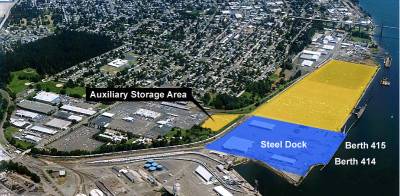|
Week of October 21, 2002 Special Report |
|
LOOKING FOR A PREVIOUS STORY? CHECK THE ARCHIVE.
By ADAM BRUNS, Site Selection Managing Editor
PORTLAND, Ore. – After receiving approval from the Port of Portland (www.portofportland.com) board of commissioners two weeks ago, Toyota Motor Sales USA (www.toyota.com) will embark on a 15-year, annual $1.4-million marine terminal lease that will enable it to invest upwards of $30 million in a $40-million facility redevelopment project.
Sanford Smith, national real estate manager for Toyota Motor Sales, says the Oregon project will do wonders for the bottom line at the same time it adheres to the company's "Process Green" environmental philosophy.
(Smith will discuss "Process Green" at the Industrial Asset Management Council's Oct. 27-30 Professional Forum in Savannah, Ga. For more information and registration, go to www.IAMC.org.) "The facility is nearly 20 acres (8.1 hectares) smaller than the current facility, yet capable of processing the same number of vehicles due to a more efficient layout," Smith told Site Selection. "The flow on the new facility will be linear from the first point of rest to the processing area to the load lines for outbound transportation. "This will result in more efficient vehicle handling, less driving of vehicles and a simpler process," he noted. "The new building will have the flexibility due to its design to adapt to our needs as post-production options evolve." In fact, the project calls for six new energy-efficient buildings on its leased property, for a combined 97,600 sq. ft. (9,067 sq. m.) of interior space. The buildings include an office, an accessory installation center, wash and fueling stations, a guard house, and a body shop. Toyota will aim to obtain LEED (Leadership in Energy and Environmental Design) certification for its new, energy-efficient buildings via the Green Building Rating System. That rating system is based on a voluntary, consensus-based national standard for developing high-performance, sustainable buildings. The green checklist spans issues that include such things as wetland non-disturbance, alternative transportation options for workers, indoor air quality, neighborhood light pollution, recycled-content building materials, and proper water and energy management techniques. Proactive Traffic Redirection
"I applaud the Port and Toyota for bringing this project to our attention early in the planning process and for really listening to what we had to say," said Robin Plance, chair of the St. Johns Neighborhood Association. "It's important for residents to have a voice in economic vitality projects planned for their neighborhoods. In our case, the Port and Toyota have helped redirect heavy truck traffic out of most residential sections of our neighborhood, which makes for safer, quieter streets." The company almost redirected traffic to another location altogether, all part of doing due diligence when a lease period is coming to an end. Port Officials: Washington Cities Also Contenders Two Washington cities also contended with North Portland for the project, according to Port of Portland officials."They looked at Tacoma and Longview, Wash., as alternative sites to Portland, and requested that all three respond to an RFP for the development of a facility that would replace what they have here," explained Aaron Ellis, maritime media relations manager for the Port of Portland. "It's been almost a three-year process of looking at alternatives, then choosing to maintain and refurbish, taking the existing operation that is split, adding some acreage, getting rid of some, and putting it all together on one site," Ellis added. The work that automakers perform at the port closely resembles an assembly line, adding on elements like running boards, audio systems, tow hitches and roof racks. Honda and Hyundai farm out this work to Auto Warehousing Co., which is not the only service provider firm benefiting from a critical mass of vehicles using Portland as a nexus. Toyota, however, does this work itself - only now that work will be performed on one continuous parcel, not four separate tracts.
Port Boast Strong Rail, Truck Links The Port originally opened in 1919, and the first load of cars hit Portland in 1956 - a ship full of Volkswagen Beetles. Today, Portland handles the most automobiles of any port on the North American West Coast, and ranks third nationally, moving around nine percent of all imported and exported U.S. cars. A location 105 miles (167 kilometers) inland from the ocean makes it even more attractive to carmakers, limiting exposure to salt during loading and unloading.Perhaps more important than the shipping channels are the truck and rail connections those ships make: Around 85 percent of all vehicles imported at the Port of Portland are immediately transported by truck or rail to the nation's interior. Rail from Portland is especially attractive, as the route inland is the only one on the whole coast to follow the river grade, without having to traverse mountains. This geographical fact has induced major railroads to invest heavily in their own infrastructure and facilities there. Exclusive Leases Bolster Development But just as crucial to the process has been the implementation of exclusive lease agreements between the port and companies like Toyota, Hyundai and Honda. Toyota was the first Asian automaker to sign a long-term lease there, on 50 acres (20.2 hectares) in 1972.The automaker's acreage had doubled prior to the new agreement, which takes the area down to an efficient 82 acres (33.2 hectares) from what had become a less-than-ideal arrangement.
Currently, Toyota processes its 160,000 new vehicles annually in a 67,000-sq.-ft. (6,224.3-sq.-m.), 26-year-old complex located on a hill above the Port's Terminal 4. "They had to drive these cars all the way up and back, then load them into railcars for shipment east," explains Ellis. "They put a lot of miles on the cars just doing that, and it was inefficient." Inefficiency is a word that's anathema to the continuous improvement ideals of Toyota, as well as those of the Port of Portland. "As our project manager told the commissioners this morning, 'This is one of our most premier customers and one of our most antiquated sites'," said Ellis, who sees Toyota as the cornerstone of the Port's 10-year master plan. "We need to modernize it and make it amenable to all the needs of the 21st century, in terms of efficiency, environmental aspects and cost effectiveness. "In all those areas," Ellis added, "Toyota's going to change it by leaps and bounds." West Coast Ports Crucial to Toyota Toyota has been one of the most visibly affected OEMs during the West Coast ports dispute.Asked what role he and his corporate real estate colleagues in Toyota's other divisions play in helping to manage such a crisis, National Real Estate Manager Sanford Smith explained, "Toyota is not directly involved in the contract discussions. However, we remain in regular contact with our shipping companies regarding the issue. Toyota remains hopeful that the ILWU (International Longshore and Warehouse Union) and the PMA (Pacific Maritime Association) will bargain in good faith and ultimately reach an accord." Consistent with company operating philosophy, many of the parts used at Toyota's North American manufacturing plants are U.S.-sourced. And Toyota imports fewer than 40 percent of its vehicles sold in North America. But about two-thirds of those imports come through two ports that use ILWU labor - Portland and Los Angeles/Long Beach. Toyota also exports vehicles to Japan and Taiwan, as well as Europe and other locations, having shipped out 10,575 vehicles in 2001. "On average, ships carrying our vehicles arrive every two to three days," said Smith. "Typically, there are about 3,500-4,500 vehicles on each ship. Ships transporting parts arrive daily with approximately 25 containers per shipment." One sticking point in union negotiations has been the ILWU's concern that new technology on the docks, such as the use of container-management software programs, means less high-paying jobs for longshoremen. Smith points out that the automation issue at the ports has no direct impact on Toyota's port operations. "However, indirectly, it could improve lead time, enable lower rates for the dray and increased productivity," he explained. "For instance, truck drivers would be able to turn more loads and provide more efficient gate operations."
©2002 Conway Data, Inc. All rights reserved. Data is from many sources and is not warranted to be accurate or current.
|




